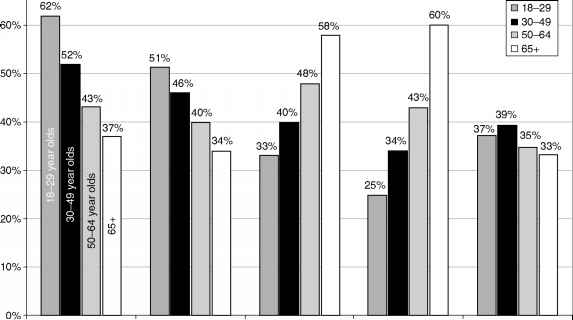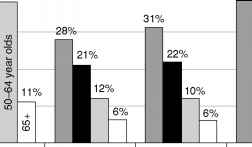Consumer usage of mobile CoMMuNiCATioN DEviCEs
The 3G handsets, which are now widely in use in parts of the globe, offer users a new data network with more bandwidth than the original analog and first-generation digital cellular phone service. The wireless data services continue to evolve. Marguerite Reardon (2008) wrote in CNET news, "The ink on the checks written to pay for mobile operator's 3G wireless networks is barely dry, and operators are already thinking of their next generation networks" (http://www.news.com/2102-1039_3-6229811.html). The Worldwide Interoperability for Microwave Access, or WiMAX platform, offers consumers the ability to utilize all the different types of wireless communication systems in the marketplace; in other words, it offers interoperability between different types of devices including cell phones, PDAs, and laptops. In 2008, Sprint Nextel committed to spending $5 billion on using the technology. The proposed network may cover up to two miles from one base station and
Those who say it would be very hard to give up ...

Cell phone Internet Television Landline phone E-mail
FIGURE 14.1
Consumer willingness to give up entertainment/communication technologies.
Cell phone Internet Television Landline phone E-mail
FIGURE 14.1
Consumer willingness to give up entertainment/communication technologies.
deliver speeds of up to 12 Mbps. However, WiMAX faces competition from other standards, such as long term standard (LTE),1 that are entering the marketplace.
The Pew Internet and American Life Project (2008) has also reported that as of December 2007, 62% of Americans have had some experience with mobile access for activities other than voice communication, either through mobile phones or wireless laptops. The most popular alternate use for cell phones is text messaging, with 58% of cell phone users stating they have used their device for text messaging. Equally, 58% have used their cell phones to take a picture, whereas only 17% have used their handheld device to play music and only 10% to watch a video. Of interest to the Pew researchers, nonwhites, specifically African Americans and English-speaking Hispanics, were more likely to engage in media activities other than voice phone service than their white counterparts.
1 LET is a new wireless standard expected to enable downlink/uplink peak data rates above
100 Mbps/50 Mbps.
Mobile data and communication activities by race
□ Hispanic

Send or receive text Send or receive Access the Internet Play music Send or receive Watch a video messages e-mail instant messages
FIGURE 14.2
Mobile communications activities by ethnic background. (Source: Pew Internet and American Life.)
Send or receive text Send or receive Access the Internet Play music Send or receive Watch a video messages e-mail instant messages
FIGURE 14.2
Mobile communications activities by ethnic background. (Source: Pew Internet and American Life.)
Mobile device usage also varies by age, with younger adults much more likely to use these devices for text messaging and all other nonvoice activities. In all categories, usage decreased with age, thus underscoring the vast generational differences that exist between a generation that has grown up around computers and an older generation whose computer experience is limited to adulthood. In her article, "Text Messaging on Rise with Young People," Martha Irvine (2006) stated, "the former darling of high-tech communication [e-mail] is losing favor to instant and text messaging." The article continued to say that young people see e-mail as a way to reach older people such as their parents, but are, themselves, increasingly using text messaging over e-mail as a means to stay in touch with each other. They associate e-mail with work, school, and spam.
With text messaging already in high gear for younger demographics, and mobile Internet access on the rise in the United States among young people, the United States is expected to catch up to Asia and Europe in Internet use via mobile handsets, offering marketers and musicians a chance to communicate with fans in innovative new ways.
Mobile data and communication activities by age

FiGURE 14.3
Use of mobile communications by age group. (Source: Pew Internet and American Life.)
Send or receive Send or receive Access the Internet Play music Send or receive Watch a video text messages e-mail instant messages
FiGURE 14.3
Use of mobile communications by age group. (Source: Pew Internet and American Life.)
On the m-commerce (mobile commerce) front, in a study by LodeStar Universal—which included the United Sates, Brazil, Russia, Pakistan, India, China, and Japan—e-commerce and financial transactions were touted as showing promise, with 81% of Japanese respondents claiming to have already used the services. In the United States, banks are beginning to offer banking services via cell phone, including checking on account balances, paying bills, and transferring funds, and concert promoters are beginning to use cell phones for ticket sales and delivery (see Chapter 15).
Was this article helpful?

